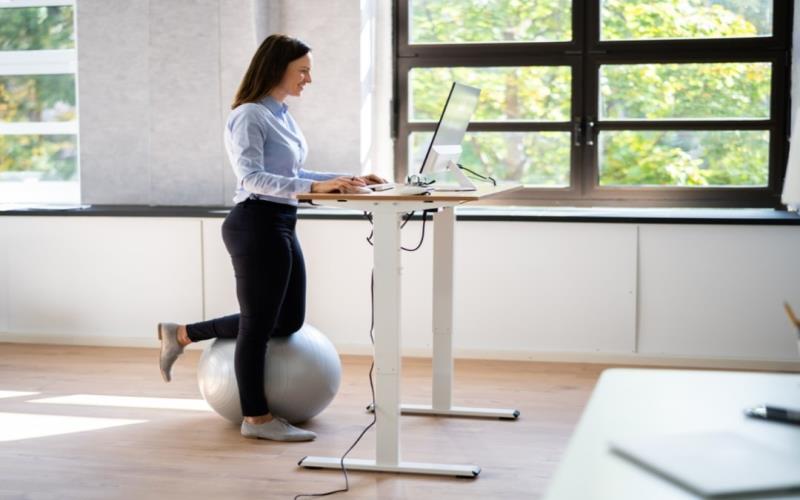Long hours of sitting have become the norm in the modern workplace. However, research has shown that prolonged sitting can have serious health implications, including obesity, cardiovascular diseases, and musculoskeletal problems. This has led to the rise in popularity of standing desks, which provide a healthier and more productive alternative to traditional desks. By allowing users to switch between sitting and standing, these desks promote better posture, increased energy, and improved efficiency. In this article, let’s explore the key benefits of using a standing desk for both health and productivity.
Health Benefits of Standing Desks
1. Reduces the Risk of Weight Gain and Obesity
Weight gain occurs when more calories are consumed than burned. Sitting for long periods slows metabolism, reducing calorie expenditure. Standing burns more calories than sitting, and incorporating movement, such as shifting weight or stretching, further increases energy expenditure. Over time, this can contribute to better weight management and reduced risk of obesity.
2. Lowers the Risk of Heart Disease
Studies have shown that prolonged sitting is associated with an increased risk of heart disease. Standing and incorporating movement can help improve circulation, regulate blood pressure, and reduce cholesterol levels. A standing desk encourages users to remain more active, lowering the likelihood of developing cardiovascular conditions.
3. Reduces Back and Neck Pain
One of the most common workplace complaints is back and neck pain, often caused by poor posture and prolonged sitting. Standing desks promote better spinal alignment and reduce the strain on the lower back. Alternating between sitting and standing can alleviate discomfort and prevent chronic pain conditions related to poor posture.
4. Improves Posture and Reduces Musculoskeletal Issues
Using a standing desk encourages users to maintain proper posture, keeping the spine aligned and reducing the risk of musculoskeletal problems. With the correct desk height and monitor positioning, individuals can prevent slouching and maintain a healthier posture throughout the day.
5. Boosts Energy Levels and Reduces Fatigue
Sitting for extended periods can lead to sluggishness and reduced energy levels. Standing desks promote increased blood flow and oxygen circulation, leading to greater alertness and decreased fatigue. Employees using standing desks often report feeling more energized and engaged in their work.
6. May Reduce the Risk of Type 2 Diabetes and Other Metabolic Conditions
Extended sitting has been linked to insulin resistance, which increases the risk of developing type 2 diabetes. Standing and moving throughout the day help regulate blood sugar levels and improve insulin sensitivity. This can be particularly beneficial for individuals at risk of metabolic disorders.
Productivity Benefits of Standing Desks
1. Enhances Focus and Concentration
Standing desks contribute to improved focus by increasing circulation and reducing mental fatigue. Employees who alternate between sitting and standing experience higher levels of concentration, which leads to enhanced work efficiency and better performance.
2. Increases Engagement and Collaboration
Many modern workplaces encourage standing meetings and collaborative workspaces with standing desks. This setup promotes dynamic discussions, increased engagement, and more effective teamwork. Standing meetings also tend to be shorter and more productive, saving time and increasing efficiency.
3. Reduces Workplace Stress and Enhances Mood
Physical movement has been linked to improved mental well-being. Standing desks encourage movement, which helps reduce stress and anxiety levels. Employees who use standing desks often report feeling happier and more satisfied with their work environment.
4. Encourages Movement and Reduces Sedentary Behavior
A standing desk does more than just provide an alternative to sitting—it encourages overall movement. Whether it’s shifting weight, stretching, or walking short distances, these micro-movements help prevent the negative effects of a sedentary lifestyle.
5. Improves Work Performance and Efficiency
Research suggests that employees using standing desks tend to complete tasks more efficiently than those who sit all day. The increased energy, focus, and reduced discomfort lead to better overall job performance.
How to Use a Standing Desk Effectively
To maximize the benefits of a standing desk, it is important to use it correctly. Here are some key tips:
- Start Gradually – Begin by standing for short periods and gradually increase the duration to avoid fatigue.
- Maintain Proper Ergonomics – Position the monitor at eye level and keep wrists straight while typing to prevent strain.
- Use an Anti-Fatigue Mat – Standing for long periods can be tiring. A cushioned mat helps reduce strain on the feet and legs.
- Wear Comfortable Shoes – Supportive footwear can help reduce foot pain and improve posture.
- Incorporate Movement – Shift weight, stretch, or take short walks to keep muscles engaged.
- Alternate Between Sitting and Standing – A balanced approach is key. Sitting periodically helps prevent excessive strain on the legs and feet.
Conclusion
Standing desks offer a wide range of benefits, from improving health and posture to boosting productivity and focus. By reducing the risks associated with prolonged sitting and encouraging movement, they contribute to a healthier and more efficient work environment. Whether in an office setting or a home workspace, investing in a standing desk can lead to long-term physical and mental well-being. To make the most of a standing desk, individuals should gradually transition, maintain proper ergonomics, and incorporate movement throughout the day. With these practices in place, standing desks can revolutionize the way we work, promoting a healthier and more productive lifestyle.

